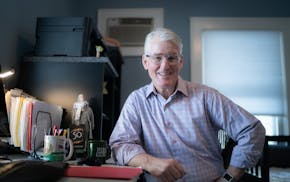If someone extended a hand in greeting in the past few days and you didn't shake it, maybe it got a little awkward.
Time to get over it.
Leaving out traditional greetings like a firm handshake in business is a small part of what is called social distancing, a term that covers what people do to maintain some space between themselves and others. It's a way to cut down risk of spreading the new-to-humans virus that causes the COVID-19 respiratory illness.
The Centers for Disease Control describes social distancing as "remaining out of congregate settings, avoiding mass gatherings, and maintaining distance (approximately 6 feet or 2 meters) from others when possible."
Minnesotans, and everyone else, need to start opening up some distance now. It's not just beneficial to your health but your family's, your colleagues' and all of us.
I have no training or experience in public health, but it's clear we need to do whatever we can — whatever we can — to slow the outbreak and keep our health care system from getting overloaded.
There hasn't been a lot of eagerness to discuss social distancing in the Twin Cities business community this week, based on responses to my inquiries to employers. That's understandable. The situation is fluid.
Wednesday morning at a coffee shop, I saw people warmly greeting each other with handshakes. By the end of the day, the National Basketball Association had suspended its season.
Executives at local companies with operations in Asia must be well aware that concerted efforts to keep people apart had an effect there. Quarantines of the public in some cases, and isolation of people who have been identified as infected, slowed the outbreak. It's important to understand how places like Hong Kong and South Korea managed to do that, although a new cluster of cases in Seoul on Wednesday put off hopes of a near-term decline in South Korea.
It hasn't been business as usual.
While forecasting is of course best left to experts, it's difficult to imagine a full schedule of professional conferences, trade shows and the like resuming any time soon.
Some meetings will likely move online, but the postponement of conferences will come at a cost to business — and not just the lost revenue for host facilities and travel providers. Part of the value (and the fun) of going to these things is what happens by accident, a chance meeting with a future customer or partner.
Instructing somebody to cancel a big meeting set for next week or work from home if possible seem like easy decisions to implement. Much more challenging is continuing to do the work inside an employer's facilities safely, adopting social distancing practices.
"When you think about social distancing, the first thing that comes into play in the workplace is not having sick people in your workplace," said Paul Aasen, president of the nonprofit Minnesota Safety Council. "That should be a no-brainer, but it is interesting how … it ripples into a lot of co-factors."
First on this list for Aasen, who once studied public health at the University of Minnesota, is whether clear paid-leave policies exist. "This no-work, no-pay potential has a direct impact on the ability to adopt that social distancing strategy," he said.
Another big factor might be considered company culture, what he called the "true level" of support for efforts to prevent the spread of infectious disease.
Senior executives will insist on maintaining a healthy workplace, he said, but down in the supervisory chain the employees may have heard a more powerful unofficial message — that they can't miss work if it means missing a sales or production goal. That has to stop.
It's also on us as individuals to take this seriously, as a state infectious disease official noted this week that a person who was sick went into work, and was later confirmed as infected with the virus.
In an interview earlier this week, Aasen said his organization has been regularly pushing out information to the Safety Council membership, about 1,200 Minnesota organizations as of last count, from the Centers for Disease Control and Prevention and other agencies.
Several members have asked about adopting social distancing practices, he said. The Safety Council is encouraging members to follow CDC guidance. That includes social distancing when possible and other infectious disease controls, including hand washing. But members have not yet asked for specific advice on how to do it.
Maintaining safety, he explained, starts with designing the right process, then educating all the workers on what that is, then really enforcing it.
Some ideas employers might consider include splitting into shifts, having a facility with half as many people in it as usual, Aasen said. Another variation of the same idea, maybe for employers with workers scattered around a production floor, is to have the staff start work at slightly different times. That allows people to come in separately rather than all coming through the employee entrance in the same few minutes.
New rules might be needed for the breakroom, too.
Workers should get a break but at times and in space where they can keep their distance from others.
The challenges are trickier for employees who leave the facility and go work at customer sites. The need for home and building services, for example, won't go away. Water heaters will fail and sink drains will need to be unclogged.
The Safety Council has people go out to lead training sessions at member sites, Aasen said. The staff is working on a process that would let an employee leave a facility if he or she did not think it was safe.
He's even been thinking about how to get people to stop shaking hands, at least for awhile.
"Everyone thinks it would be hard to do," he said. "But there was a point in time in my career where you thought casual Friday would never exist."
lee.schafer@startribune.com 612-673-4302

Schafer: What do you really need to retire?

Schafer: How doing business can be a bit more like Christmas morning

Schafer: There won't soon be another opportunity to rethink the I-94 corridor

Schafer: The fruits of Honeywell's long-game dedication to quantum computer now being seen


